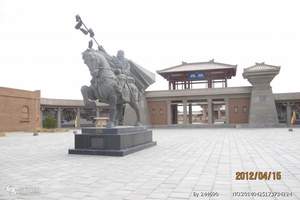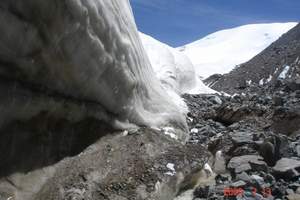敦煌阳关景区
4A地址:甘肃·酒泉 甘肃省酒泉市敦煌市南湖乡办林场边
开放时间: 阳关景区常年对外开放,四季景观迥异,各具特色!来敦煌,到阳关景区观赏日出和日落也是您最佳的选择地!最佳参观时间为:早晨和下午。
门票信息:欣欣门票价:60元起。

更多热门城市
景点门票
| 名称 | 供应商 | 预定时间 | 价格 | ||
|---|---|---|---|---|---|
| 观光车票 | 同程旅游 | 当天19:00前可订 | ¥ 10 | ||
|
入园方式
无需换票,持[入园辅助码]直接入园,入园地址:景区检票口; 包含项目成人票+观光车票1张,预订成功30分钟后生效。 预订说明①另付费项目:景区内其他二消项目需另付费(自愿购买原则); 如您需要发票,请至景区售票处领取。 退款说明如需退款,可登录同程旅游app至订单详情页申请。 |
|||||
| 成人票(当天下单后30分钟生效) | 同程旅游 | 当天19:30前可订 | ¥ 40 | ||
|
入园方式
无需换票,持[入园辅助码]直接入园,入园地址:景区检票口; 包含项目成人票+观光车票1张,预订成功30分钟后生效。 预订说明①另付费项目:景区内其他二消项目需另付费(自愿购买原则); 如您需要发票,请至景区售票处领取。 退款说明如需退款,可登录同程旅游app至订单详情页申请。 |
|||||
| 成人票+观光车票(当天下单后30分钟生效) | 同程旅游 | 当天19:30前可订 | ¥ 50 | ||
|
入园方式
无需换票,持[入园辅助码]直接入园,入园地址:景区检票口; 包含项目成人票+观光车票1张,预订成功30分钟后生效。 预订说明①另付费项目:景区内其他二消项目需另付费(自愿购买原则); 如您需要发票,请至景区售票处领取。 退款说明如需退款,可登录同程旅游app至订单详情页申请。 |
|||||
景点印象
现在的阳关已经失去了他往日的繁华,留给我们的只是无尽的想象和后人们的凭吊。
感谢您的到来,阳关吸引人的地方就是其沧桑的历史沉积,在这里我们凭吊古人,认识那段辉煌的历史,“犯我强汉者,随远必诛”,多少的豪气云天。
现在的古阳关遗址已经看不到往日的繁华,只剩一个烽燧在那里,仿古建筑主要是展示昔日在阳关的繁华和尽可能还原古阳关都尉府的原貌,其实到这里主要是凭吊那段历史感受“明犯强汉者,虽远必诛”的豪迈。谢谢您能来阳关。
现在的古阳关遗址已经看不到往日的繁华,只剩一个烽燧在那里,仿古建筑主要是展示昔日在阳关的繁华和尽可能还原古阳关都尉府的原貌,其实到这里主要是凭吊那段历史感受“明犯强汉者,虽远必诛”的豪迈。谢谢您能来阳关。
阳关景区特色多种多样,有特色活动,休闲体验来到这里首先了解敦煌的历史,第一站应该在这里,随后去其他景区,就更深入了。在这里我能切身的感受到大漠边塞风光带来的悲壮雄浑之感。有机会一定在去感受一下!
王维的阳关三叠把我们吸引来,但是能称得上“关”的建筑或者遗存基本不剩什么了。远远一处高高的烽火台。可能为了让我们游客不太失望?建了新的展览馆,门票里还包括讲解费,可惜我们没有时间听。展品照片为多,也没太大意思。
阳关,是古代丝绸之路上的要冲,因为在玉门关之南,所以命名阳关。千年之后,现在人在这里仿古修起了一座古城。这座古城是仿汉建造的。进入古城之后,仿佛置身与千年之前。随便转转,进入博物馆听讲解员讲解一番。城门上的四个大字我感觉很有感觉“东望长安”!
迈过长满骆驼刺的戈壁,遥望蓝天白云下的阳关,因为日照的强烈把它映得格外金黄,虽然只剩下一个泥土制的建筑,
从玉门关、雅丹玩好回程去的。一路上竟是成片的戈壁,快到阳关时才路过一个村子,看到一些绿色(当地农民种的葡萄)。据司机大哥说还要两个月才能熟。当地日照非常长而且强烈,葡萄应该会很好吃啊。景点里搞了一个博物馆,有专人讲解,还算可以。从博物馆往上走是当年的古迹,由于实在太晒了,大家都选择交通工具,有电瓶车、驴车还可以骑马。其实真正的阳关只看到一个小土墩,据说是当年的烽火燧台。另外还遥望了一下阳关道(骑马可以走走阳关道)。据导游说天气好的时候可以看到阿尔金雪山,我们那天只看到沙尘暴。。。
去阳关的时候是夏天,天气很热,满眼都是黄沙,感觉荒凉又开阔,然后在一块石头上看到那句诗,真的和古人产生了共鸣一样
即使这片地已经被风雨蚀去,即使这片土以已经被沙尘覆盖,但每走过的一个脚印,都埋藏着一段深刻的历史,远处的遗迹,近处的丝绸之路,都述说的过去!
很荒凉,很宽阔的荒凉,视线所及的只是干净的蓝天下的一段长长矮矮的烽燧遗址,让人不由得问:历史远去之际,尚有几人为昨日怀念?
This is the 2nd pass of the two most west fortresses (Yuan Guan Pass and Yumen Pass) of the ancient Silk Road. Yuan Guan Pass (陽關) got its name because it is located south of Yumen Pass. Yuan in Chinese means sunny and also means south. It was built at the same time as Yumen Pass by the order of Emperor Wudi (漢武帝) of Han dynasty. It was used for consolidating the border defense as well as developing the remote western region (西域). Yuan Guan Pass is 80 km (50 mi) away from Dunhuang city in the southwest region. In 629, the famous Xuan Zang (玄奘), a great Chinese Buddhist monk pilgrimaged to India in search of Buddhist scriptures, and returned via Yuan Guan 16 years later. Today most of the Yuan Guan was eroded and buried under sand. It is impossible to recover with current technology. Chinese government lists it as a protection area. The only remain is the broken beacon tower.We came here after visiting Yumen Pass in the late afternoon. A private owned Yangguan Museum was built onsite based on the old Yang Guan of the Han Dynasty. Yangguan Museum first opened to the public in 2003 with exhibitions showing the history, culture, weapons, buildings etc. of the Yng Guan. Unfortunately, we were not allowed to take photos inside the exhibition hall. While waiting for the guide (included in the ticket), we went to the top of the city wall and saw several defense and attack weapons on display. The tour also included a ride on a small tour bus to the mountain side of the Yang Guan ruins. It also provided us a good chance to see the broken beacon tower. After the tour bus dropped us off, it took us few minutes walking to the site where the original Yang Guan was built. Once we were on top of the hill, we realized why the Yang Guan was built here. There was nothing but endless desert and it was a good defense spot.Due to the climate and underground springs, this area also is a hometown of tasty grapes. We actually visited a small village (二墩村) in the middle of desert in between Yumen Pass and Yang Guan. The day we visited was in the middle of the grapes harvest season. We bought 4 bunches of grapes and they were delicious. I think it might be the low humidity that causes the high concentration of sugar. We also found there were many huge barn-like buildings used for making raisins utilizing the nature desert climate. Don’t forget to taste those juicy and sweet fruits when you visit Dunhuang.
The ruins and remnants of the Han Dynasty strongholds made significant marks on the ancient Silk Road.
What you see today as Yangguan Pass -- a 70km drive southwest of Dunhuang -- is actually the ruins of a beacon tower indicating the possible location of the original gate nearby. The original Yangguan was first built in 150BC and has not been preserved through the century. No one knows where is the exact location of the real Yangguan Pass. Therefore, what you're paying RMB 50 admission ticket to see is just the sandy beacon tower at the top of the hill -- everything else is basically newly built in modern times. It takes a lot of imagination to understand the former splendor and poetic meaning of this place. In the Han dynasty through to Tang dynasty, this is one of the two gates where traders, Buddhist pilgrims and other travelers have to go through in order to leave China and head towards India or the Middle East. In Tang dynasty, the Buddhist monk Xuanzhuang, popularized in the novel "Journey to the West" (aka The Monkey King), returned from India via the Yangguan Gate carrying important Buddhist texts and translations. I'm told that on the south of the hilltop, the locals call this the "antique beach" because over the years, many pottery, jewelry, coins from ancient times, as well as the remnants of houses etc. were found in this area. In reality, I didn't see anything but barren land on the southern slopes of the hill. Today, what you find is a very basic museum describing the Han dynasty (when Yangguan was first built) -- people's lives, what weapons the military used for defence, what the farms looked like, etc. All very basic things you can see in major Chinese museums, if you have visited Beijing's museums you can absolutely skip this part. If you're visiting in the summer and if you have children with you, there are war games here you might like to take advantage of. But I visited during low season, when everything was practically closed down, so I am not sure of the prices. If you pay RMB 20 to take an electric vehicle up the hill and back (essential for visiting during the summer), then you are provided with a tour guide for free. However, if you choose to walk up the hill yourself, the tour guide will not walk up with you. Since I was visiting in mid-February when it was still -5 degrees C during the day, the site had no other tourists and everything looked deserted. I was told the scenery is great during the summer. Perhaps when you visit, you'll see what I missed!





